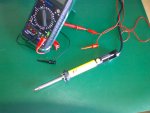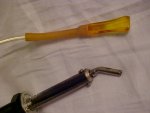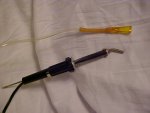Hi Protolisk,
I used to teach what was called "Laborotory Standard High Reliability Hand Soldering" in the RAAF (Royal Australian Air Force)many years ago. That included re-working multilayer PC boards.
Other than using the right tool for the job, the bottom line is cleanliness. Everything must be clean before you solder - The copper pad the component goes into, the soldering iron tip , the component lead and the solder. The means mechanical cleaning and then chemical cleaning.
It was not unusual to take half an hour to put one resistor in correctly. Not practical in a commercial sense but when absolute reliability was needed, it was the only way to go.
No matter what, do NOT put lots of solder onto a joint. There must be a minimum of solder, just enough to cover the pad and having a small cone around the lead. The solder should have a Rosin core. This helps clean and "wet" the joint so that good heat transfer and solder flow can take place.
Otherwise you will make a poor job. Sure it will work initially but over time, the joints will fail, usually at a critical time.
You must get an iron that can handle the load on it. The moment you apply solder to a tip and then apply the tip to a component and track, the tip will cool down. Sounds like what is happening in you case and you are creating what's known as a cold joint.
The iron must be able to rapidly compensate for any load on it and it should not take any longer than 1/2 second to melt solder on a track with a lead in it.
On average the tip temp must be between 320 and 360 degrees for the chance to do a good soldering job with the standard lead based solder and at least 50 deg higher for non lead based solders.
Thats why as mentioned earlier by others, a temp controlled iron is critical.
Do not base the ability of the iron on watts only - means nothing. Tip temp and the ability to maintan that temp under load is what counts. Plus; as I said earlier, the tip must be clean to transfer heat to a pad/track otherwise you're going to do a poor job.
For de-soldering, solder wick is only good for single sided boards. The moment you want to desolder from a double sided board you will run into trouble and the hand bulb desolder tool just won't cut it unless you are very lucky.
I know you're only 14, therefore have a serious lack of money but if possible try to save up for and get you parents to help with getting a decent re-work station. It will be worth it's weight in gold if you take up electronics seriously and will last for most of a lifetime. I have a Royel rework station that does everything, about 20-25 years old and cost a fortune back then. Still going strong with only the vacuum pump needing minor servicing.
At the very least get a good temp controlled iron.
Good luck.








